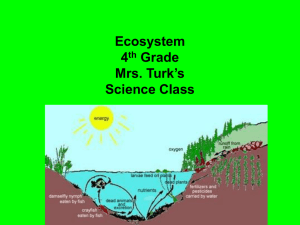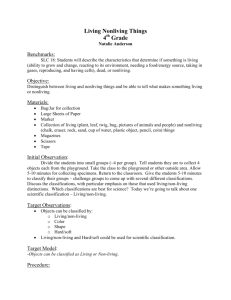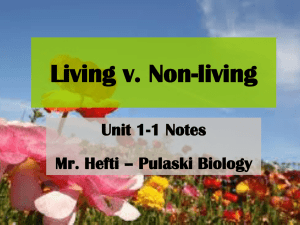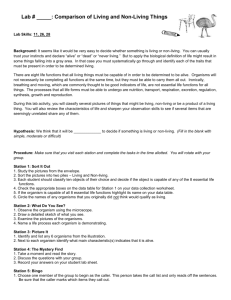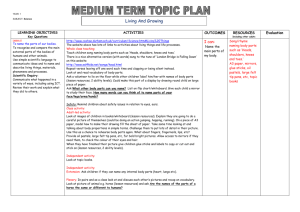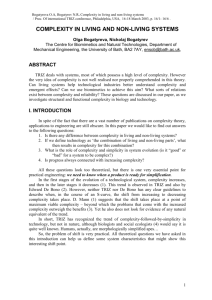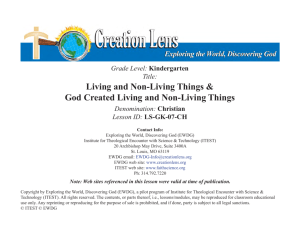Gist: Living-Nonliving Basic Needs
advertisement
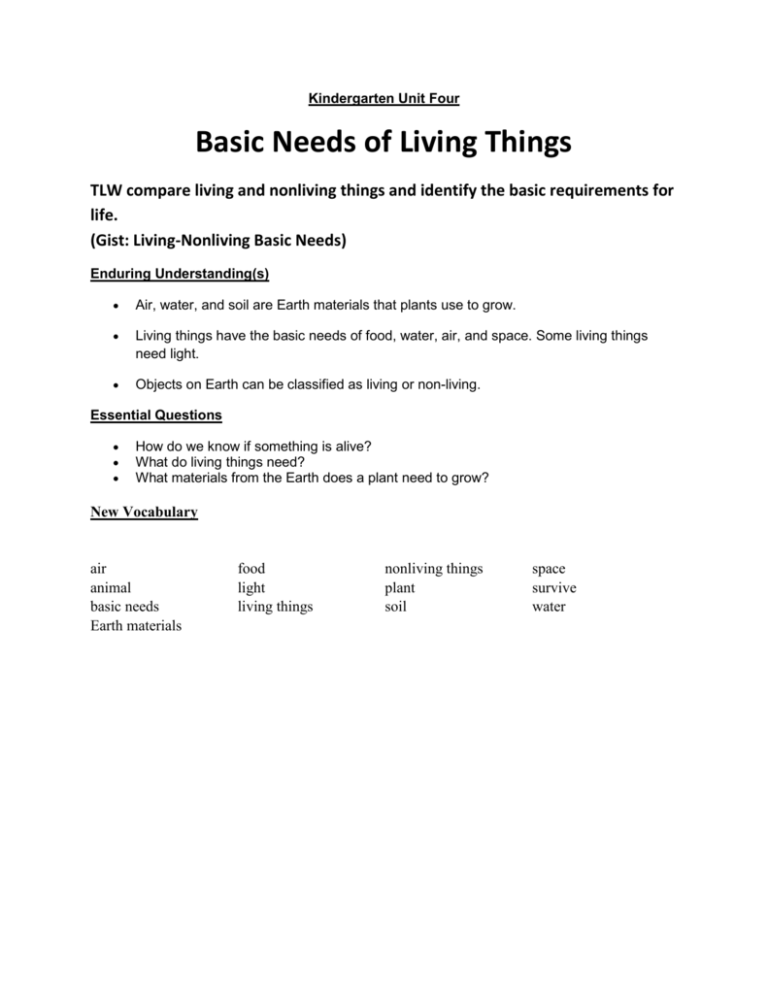
Kindergarten Unit Four Basic Needs of Living Things TLW compare living and nonliving things and identify the basic requirements for life. (Gist: Living-Nonliving Basic Needs) Enduring Understanding(s) Air, water, and soil are Earth materials that plants use to grow. Living things have the basic needs of food, water, air, and space. Some living things need light. Objects on Earth can be classified as living or non-living. Essential Questions How do we know if something is alive? What do living things need? What materials from the Earth does a plant need to grow? New Vocabulary air animal basic needs Earth materials food light living things nonliving things plant soil space survive water Concepts & Information There are many different kinds of living things, including plants and animals. Basic life-supporting needs of animals are water, air, food and habitat (shelter or space). Basic life-supporting needs for plants are water, air and light. Photosynthesis is the process employed when plants use light to produce their food from air and water. All living things grow, repair, change and reproduce. Non-living things have no life-supporting needs. Many non-living items can be considered "once-living" if they were once alive but no longer are living (e.g., brown leaf on the ground). Common Misconceptions Many students don’t realize that air is needed for life. Real-World Connections All organisms have basic needs (air, water, food or nutrition, and space). Young learners have a difficult time relating the basic needs of living things to themselves and other familiar animals. The recognition of plants as living things and the identification of trees as plants are also key at this stage in their understanding of living and nonliving things. The classification of things as living and nonliving is the first step in classification of organisms. All living things have basic life functions: need food, grow, and have young. Living things include all plants and animals, including humans. Nonliving things include sand, rocks, clouds, and all manmade items. Children’s toys are often given characteristics of living things that may add to the confusion of young learners. Media also attach living characteristics to nonliving things that students may site as living. Parts of living things, such as leaves, branches, and molted skin are examples of once living things that cannot continue living without the whole organism. It does not grow, need food, air, or water, or have young. Lesson Ideas: 1. Over a period of time, TLW collaboratively observe the differences between living and non-living items.CCSS/CE(s): L.OL.00.12; (Resource: Living/Non-Living Investigation) Students should identify and compare living and non-living things. Use BBC Schools Science Clips Ourselves link to determine student’s prior knowledge. The activity in Resource: Living/Non-Living Investigation demonstrates the differences between living or non-living when other variables are unchanged. Use Living vs. Non-living Things Quiz link as a wholeclass activity. Sorting Living and Non-living Things link 2. Given a number of non-living objects, TLW collaboratively respond to a list of questions concerning life-supporting needs.CCSS/CE(s): L.OL.00.12; Items for display in this lesson and the next should be clearly living or non-living. Suggestions for items to observe: Living Non-Living tree metal desks puppy athletic shoes goldfish rock hamster water cactus balloon Living or Non-living - Questions to Ask: 1. Does it need light? 2. Does it need food? 3. Does it need water? 4. Does it need air? 5. Does it need a place to live (space)? 3. By observing living things or illustrations of living things, TLW collaboratively determine lifesupporting needs.CCSS/CE(s): L.OL.00.11; L.OL.00.12; Repeat the activity and questions from other lessons in this Academic Standard. Students should conclude that living things need food, water, air, and space. Some living things also need light. 4. From a student generated list, TLW classify things observed on a walk as living or non-living, justifying each classification.CCSS/CE(s): L.OL.00.12; (Resource: Life-Support Needs) Discuss "once-living" things with students to help them understand that they are no longer alive. Living and Non-living lesson link gives ideas for outdoor observation and literature connections. If hula hoops, plastic hangers, or embroidery hoops are available, they can be used in place of the string as suggested on the web site. 5. TLW identify plants and animals as living things and describe how earth materials contribute to plant and animal life.CCSS/CE(s): E.SE.00.12; Many of the living things previously identified will be plants. Students should describe how plants grow in the soil and need water to grow and survive. Students should describe how animals eat plants that grow in the soil and need water and air to breathe to grow and survive. Discuss the activity from Resource: Living/Non-Living Investigation, where students grew a living plant. What were the Earth materials the bean seed needed? Write a book on your classroom habitat experience. Write a fact book about one of the animals or plants observed in the classroom or schoolyard. Garden Graphing, Sensational Springtime, pages. 107-111, AIMS for inquiry about plants Sprouting on Sponges, Sensational Springtime, AIMS, Sponge Garden, Spring into Math and Science, AIMS Instructional Resources Is it Alive? Plant and animal books and make the connection to plants and animals being alive. One Small Square, Donald Silver, 1997 Under One Rock, Anthony D. Fredericks, 2001 Animals and Their Babies, Melvin Berger, 1993 The Tiny Seed, Eric Carle, 1987 Wonderful Worms, Linda Glaser, 1992


